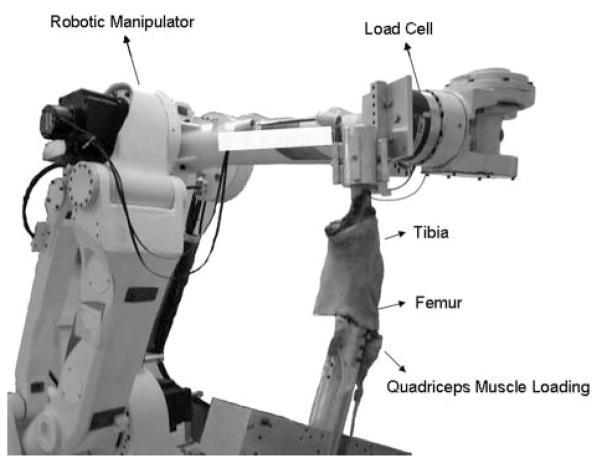Abstract
Background
The in situ forces of the anteromedial (AM) and posterolateral bundles (PL) of the anterior cruciate ligament (ACL) under simulated functional loads such as simulated muscle loads have not been reported. These data are instrumental for improvement of the anatomical double-bundle ACL reconstruction.
Hypothesis
The load-sharing patterns of the 2 bundles are complementary under simulated muscle loads.
Study Design
Descriptive laboratory study.
Methods
Eight cadaveric knees in this study were sequentially studied using a robotic testing system. Each knee was tested under 3 external loading conditions including (1) a 134-N anterior tibial load; (2) combined rotational loads of 10 N·m of valgus and 5 N·m internal tibial torques; and (3) a 400-N quadriceps muscle load with the knee at 0°, 15°, 30°, 60°, and 90° of flexion. The in situ forces of the 2 bundles of ACL were determined using the principle of superposition.
Results
Under the anterior tibial load, the PL bundle carried peak loads at full extension and concurrently had significantly lower force than the AM bundle throughout the range of flexion (P <.05). Under the combined rotational loads, the PL bundle contributed to carrying the load between 0° and 30°, although less than the AM bundle. Under simulated muscle loads, both bundles carried loads between 0° and 30°. There was no significant difference between the 2 bundle forces at all flexion angles (P > .05).
Conclusion
Under externally applied loads, in general, the AM bundle carried a greater portion of the load at all flexion angles, whereas the PL bundle only shared the load at low flexion angles. The bundles functioned in a complementary rather than a reciprocal manner to each other.
Clinical Relevance
The data appear to support the concept that both bundles function in a complementary manner. Thus, how to re-create the 2 bundle functions in an ACL reconstruction should be further investigated.
Keywords: anterior cruciate ligament, double bundle, in situ force, muscle load
It has been generally accepted in the literature that the anterior cruciate ligament (ACL) consists of 2 major functional components, the anteromedial (AM) and posterolateral (PL) bundles.2,3,9,24 Previous anatomical studies have shown that the 2 bundles function in a reciprocal manner during passive knee motion, with the PL bundle being tight in extension and the AM bundle being tight in flexion.2,4,9,13 In response to an anterior tibial load, the 2 functional bundles of the ACL were shown to carry inversely related in situ forces through the flexion-extension path of the knee, especially at near full extension, where the in situ force of the PL bundle was shown higher than the AM bundle.8,22,27,30 Under the combined rotational loads, the 2 bundles shared the load at the selected flexion angles.8,22,30
Recent in vivo studies revealed that the AM and PL bundles of the ACL have a more complementary, as opposed to reciprocal, lengthening pattern during weight-bearing flexion, especially at low flexion angles.11,14 Both bundles were observed to reach maximum length at near extension and then shorten with flexion, indicating that the ACL bundles may function differently under physiological loading conditions when compared with passive loading conditions. A similar result was obtained using a surgical navigation system to evaluate the length change and orientation of the 2 bundles in cadaveric knees.25 Our in vitro studies also found that the ACL force diminished beyond 30° of flexion under simulated muscle loads, implying that both bundles may not function at high flexion.16,18 However, no data have been reported on the AM and PL bundle forces when the knee is subjected to muscle loads. A quantitative knowledge of the in situ forces of the AM and PL bundles under physiological loads could be instrumental for understanding the ACL function and developing anatomical ACL reconstruction techniques that are aimed to reproduce the 2 functional bundles of the ACL.
The objective of this study was to measure the in situ forces of the AM and PL bundles of the ACL under simulated quadriceps muscle loads. The forces of the 2 bundles under an anterior tibial load and combined rotational loads were also examined in the study. We hypothesized that the load-sharing patterns of the AM and PL bundles would be complementary under simulated muscle loads.
MATERIALS AND METHODS
In situ forces of the AM and PL bundles were studied in 8 fresh-frozen cadaveric knee specimens with a mean age of 55 years (range, 47–60 years) and with 1 female and 7 male donors. Before the experiment, all specimens were stored at −20°C and were thawed at room temperature for 24 hours before the experiment. Each of the specimens was examined after it was completely thawed for osteoarthritis and ACL injury by fluoroscopy and manual stability evaluation. Specimens with either of these conditions were excluded from this study. The femur and tibia were truncated approximately 25 cm from the joint line, with all the soft tissues around the knee intact, and a bone screw was used to firmly secure the fibula to the tibia in its anatomical position. Each specimen was manually preconditioned by flexing the knee joint 10 times before it was installed on the robotic testing system.
A robotic testing system (Figure 1) was used to investigate the knee joint biomechanics. This testing system has been previously described in the literature.7,15–18,26,31 After the specimen was installed on the robotic testing system, a passive flexion path of the ACL intact knee was determined from 0° to 90° of flexion in 1° increment of knee flexion. A passive position along the passive flexion path was described as a position of the knee at which all resultant forces and moments at the knee center were minimal (<5 N and <0.5 N·m, respectively). The kinematic responses of each knee were then determined under 3 different sub-physiological loading conditions: an anterior tibial load of 134 N, combined torques of 10 N·m valgus and 5 N·m internal tibial torque, and a simulated quadriceps load of 400 N at selected flexion angles of 0°, 15°, 30°, 60°, and 90°. The simulated quadriceps loads were applied to the knee joint by hanging weights from a rope passing through a pulley system at each of the selected flexion angles.16,18 Under each loading condition, the robotic testing system recorded the kinematic responses of the knee joint.
Figure 1.
The robotic/UFS testing system used in this experiment with pulleys for the application of quadriceps muscle loads.
After the kinematics of the ACL intact knee were determined under the external loads at the selected flexion angles, the AM and PL bundles were identified via a medial miniarthrotomy with the knee flexed to 90° by one orthopaedic surgeon and verified by another surgeon (Figure 2). The AM or the PL bundle was cut in an alternative fashion at its femoral insertion using a No. 15 scalpel during the testing of the 8 specimens. Careful attention was paid to avoid any damage to other structures. After resection of one bundle, the miniarthrotomy and skin were repaired through a layered closure. After the repair, the kinematics of the intact knee were replayed at each of the selected flexion angles, and the forces transferred through the knee joint were recorded. To determine the amount of force experienced by the resected bundle under the external loads, the principle of superposition was used.8,22,27,30 The force within each ACL bundle was determined as the difference of the forces measured before and after transection of the bundle.16,18 A similar process was followed to resect the second bundle of the ACL, and the intact knee kinematics were again replayed to determine the forces experienced by the second bundle under the 3 external loads at each of the selected flexion angles using the principle of superposition.
Figure 2.
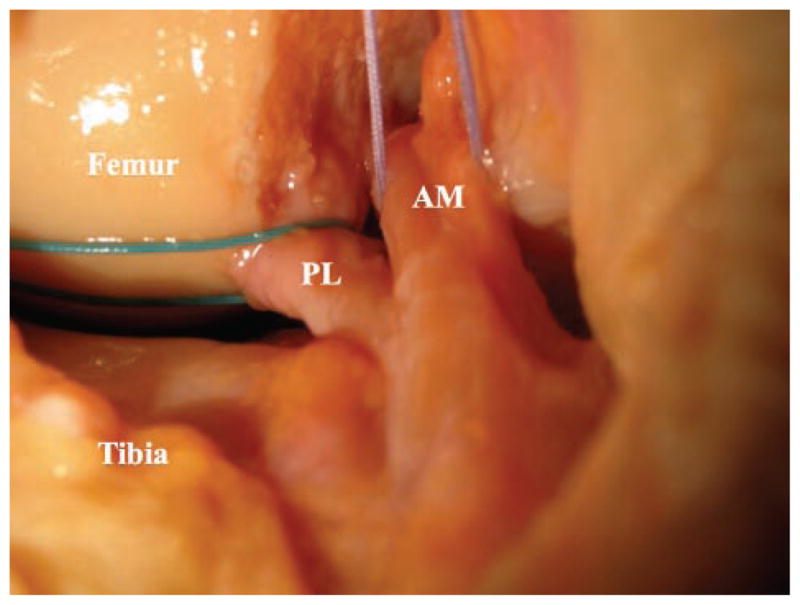
The anteromedial bundle (AMB) and posterolateral bundle (PLB) of the anterior cruciate ligament (ACL) viewed from the anterior arthrotomy of the knee. At 90° of knee flexion, the AM bundle was taut, while the PL bundle was slack.
In this experiment, each specimen was tested to determine the in situ forces experienced by each of the ACL bundles under 3 external loading conditions at the selected flexion angles. A 2-way repeated measures analysis of variance (ANOVA) was used to detect statistically significant differences in the forces experienced by the 2 bundles at the selected flexion angles under the 3 external loads. When significant differences were found, post hoc comparisons were made using the Student-Newman-Keuls test. Differences were considered statistically significant at P <.05.
RESULTS
In Situ Forces Under the 134-N Anterior Tibial Load
The in situ force of the AM bundle was relatively constant throughout the range of flexion tested (Figure 3). The peak of the in situ force of the AM bundle was 123.7 ± 26.3 N at 30° of knee flexion and a minimum of 80.2 ± 24.0 N at 90° of knee flexion. The in situ force of the AM bundle at 30° of knee flexion was significantly higher than that at 60° and 90° of flexion (P <.05).
Figure 3.
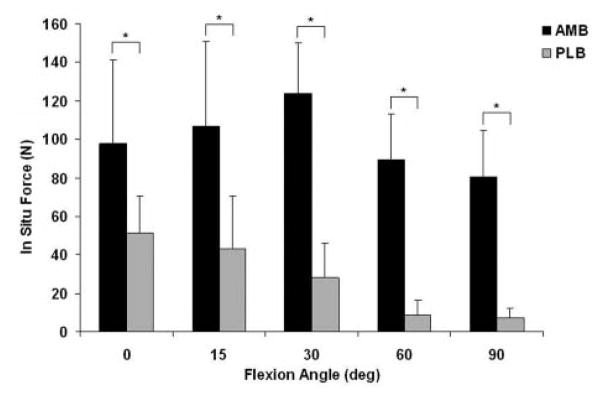
The in situ forces in the anteromedial bundle (AMB) and posterolateral bundle (PLB) in response to a 134-N anterior tibial load (*P < .05). The PL bundle carried significantly lower in situ force than the AM bundle at all flexion angles (P <.05).
The magnitude of the in situ force of the PL bundle in response to the anterior tibial load decreased with increasing knee flexion (Figure 3). The peak of the in situ force of the PL bundle was 51.3 ± 19.5 N at 0° of knee flexion and a minimum of 7.1 ± 4.8 N at 90° of flexion. Statistically significant changes in the magnitude of the in situ force of the PL bundle were seen at 60° and 90° of flexion compared with those at 0° and 15° of flexion (P <.05).
Comparison of the in situ forces of the AM and PL bundles revealed that the PL bundle carried significantly lower in situ force than the AM bundle at all flexion angles (P < .05). At 0° of flexion, the in situ force of the PL bundle was 53% of the AM bundle force. At 30°, the in situ force of the PL bundle decreased to 23% of the AM bundle. At 90°, the in situ force of the PL bundle was only 9% of the AM bundle.
In Situ Forces Under the Combined Valgus and Internal Tibial Torques
Under combined rotational loads of 10 N·m valgus and 5 N·m internal tibial torques, the in situ forces of the AM bundle were 59.9 ± 27.5 N and 75.5 ± 42.5 N at 0° and 30° of knee flexion, respectively. The forces of the PL bundle were 40.9 ± 23.7 N and 35.9 ± 31.4 N, respectively, at the 2 flexion angles (Figure 4). However, there was no significant difference between the 2 bundles at 0° of flexion, whereas the in situ force of the PL bundle was significantly lower than that of the AM bundle at 30° of flexion (P<.05).
Figure 4.
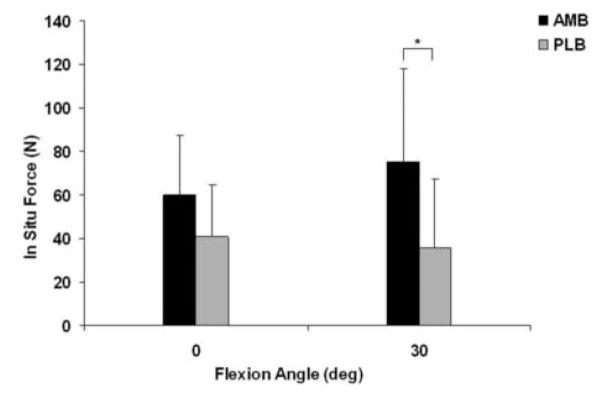
The in situ forces in the anteromedial bundle (AMB) and posterolateral bundle (PLB) in response to combined 10 N·m valgus and 5 N·m internal tibial torques (*P <.05). There was no significant difference between the 2 bundles at 0° of flexion, but the PL bundle shared significantly lower force than the AM bundle at 30° of flexion (P <.05).
In Situ Forces Under the 400-N Quadriceps Muscle Load
In response to the quadriceps muscle load, the magnitude of the in situ force of the AM bundle was a maximum of 75.2 ± 48.7 N at 15° of flexion and a minimum of 12.5 ± 10.7 N at 90° of flexion. The magnitude of the in situ force for the PL bundle was a maximum of 51.5 ± 41.6 N at 30° of knee flexion and a minimum of 8.2 ± 4.8 N at 90° of flexion. There was also no significant difference between the 2 bundle forces at all flexion angles (Figure 5). At 60° and 90°, both bundles carried similar loads less than 25 N.
Figure 5.
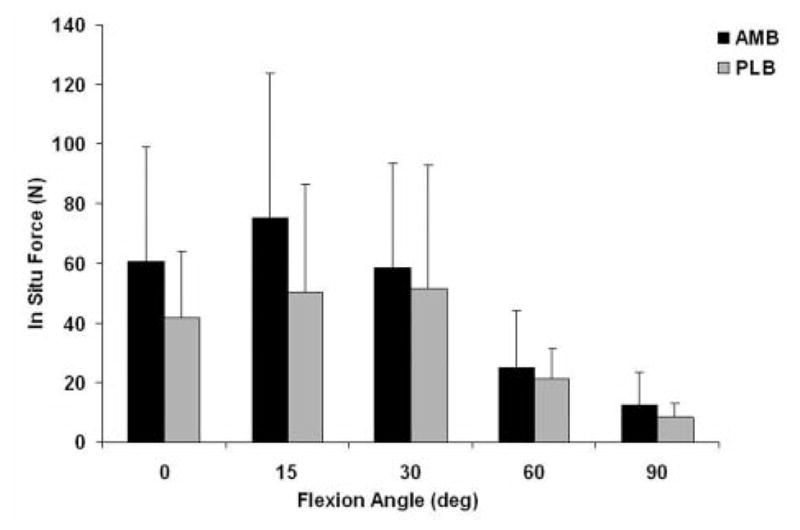
The in situ forces in the anteromedial bundle (AMB) and posterolateral bundle (PLB) in response to a 400-N quadriceps muscle load (*P <.05). There was also no significant difference between the 2 bundle forces at all flexion angles (P > .05).
DISCUSSION
This article investigated the in situ forces of the 2 functional bundles of the ACL in human knees under simulated muscle loads and passive tibial loads using cadaveric knee specimens. The data under simulated muscle loads indicated that the AM and PL bundles carried similar loads, even though on average, the loads of the AM bundle were higher than those of the PL bundle. It is interesting to note that under an anterior tibial load, both bundles carried peak loads at low flexion angles (0°–30°), whereas the PL bundle carried diminishing loads with increasing knee flexion. The PL bundle carried approximately less than 50% of the load carried by the AM bundle throughout the range of knee flexion. Under combined torque loads, the PL bundle also carried lower loads than the AM bundle, and the forces of the PL bundle decreased as flexion angle increased. Our data indicate that the AM and PL bundles function in a complementary manner. The AM and PL bundles supplement each other under various loading conditions rather than function independently. The data support our hypothesis that the load-sharing patterns of both bundles are complementary rather than reciprocal under simulated muscle loads.
The function of the AM and PL bundles of the ACL with applying various tibial loads has been reported in various studies.8,22,27,30 In a pioneer work, Girgis et al9 found that the AM bundle was tight in high flexion while the PL bundle was tight in low flexion by using palpation during passive flexion, indicating a reciprocal function of the 2 ACL bundles along the flexion path of the knee. Later, Sakane et al27 and Gabriel et al8 found that under an anterior tibial load, the PL bundle carried a higher load at low flexion and lower load at high flexion compared with the AM bundle. In general, our data showed a similar trend in the change of force magnitude of the two bundles with flexion, but the reciprocal function of the 2 bundles was not shown in our data under both the anterior tibial load and the simulated muscle loads. However, the load-sharing pattern in our study under combined rotational loads at 30° of flexion was similar to that of Gabriel et al.8 Markolf et al21 found that the PL bundle carried peak loads at full extension under an anterior tibial load and the PL bundle force sharply decreased with flexion as well. Our data on the PL bundle forces under an anterior tibial load showed a similar trend as that of Markolf et al.21
In our previous studies of the in situ force of the ACL under simulated muscle loads, the ACL was shown to carry minimal loads at high flexion angles,16,18 which implied that under muscle loads, the 2 bundles did not function at high flexion angles. This conclusion was confirmed by our data on ACL elongation during an in vivo single-legged lunge activity,11,14 where the 2 bundles were shown to decrease in length as flexion angle increased. In the present study, the 2 bundles under muscle loads were shown to carry high loads between 0° to 30° of knee flexion and minimal loads at 60° and 90°. The in vivo AM and PL bundle elongation patterns and the in vitro AM and PL bundle forces along the flexion path demonstrated consistent functional behavior.
The load sharing of the AM and PL bundles may have important clinical relevance in ACL reconstruction. The specific flexion angle for graft fixation is one of the most controversial problems surgeons face during double-bundle ACL reconstruction. There is no general consensus on the range of angles of knee flexion for graft fixation. In the literature, the 2 bundle grafts were either fixed at the same knee flexion angle or at 2 different knee flexion angles where each bundle carried the highest force.1,5,6,10,12,23,33 While recent literature suggested that the PL bundle should be fixed at or near full extension to avoid overloading the graft,1,6,10,11,14,22,25,32 the fixation of the AM bundle graft has been varied from 90° to 10° of knee flexion.1,5,6,19,20,22,28–30 Our data indicate that the AM and PL bundles carry maximal loads between 0° to 30° of flexion under various applied loads. The 2 bundles might be fixed within this range of flexion. More studies should be carried out to examine the effect of flexion angles for graft fixation on knee stability after ACL reconstruction. The clinical outcome of various graft fixation angles should also be further investigated.
Several limitations of our study should be noted. The 400-N quadriceps muscle load, half of the total body weight, is less than that experienced during daily activities. Lower muscle loads would mechanically cause less in situ forces in the ACL. Ground-reaction forces were not simulated in this study. Future investigation should focus on the improvement of the loading levels and include the simulation of ground-reaction forces to simulate more realistic knee joint function. It should be noted that the variation in the force data has been indicated by the large standard deviations, which may be due to the interspecimen variation. To eliminate the methodological variation, the 2 bundles were transected in an alternative way. The AM and PL bundles were specified by one orthopaedic surgeon first and then verified by another surgeon. The bundle separation method was similar to that used by Girgis et al.9 Finally, the in situ bundle forces of the ACL were measured under a quasistatic condition. The investigation of the bundle function of the ACL under dynamic loading conditions might be necessary.
CONCLUSION
In conclusion, our study evaluated the load sharing between the AM and the PL bundles of the ACL under 3 different loading conditions. Our findings demonstrate that the AM bundle carried a greater portion of the load within the ACL at all flexion angles under externally applied loads, whereas the PL bundle only shared the load of the ACL at low flexion angles. The data appear to support the concept that both bundles function in a complementary rather than reciprocal manner. Thus, how to recreate the 2 bundle functions in a single- or double-bundle ACL reconstruction should be further investigated.
Acknowledgments
The authors gratefully acknowledge the support of the National Institutes of Health (AR055612 & AR051078).
Footnotes
No potential conflict of interest declared.
For reprints and permission queries, please visit SAGE’s Web site at http://www.sagepub.com/journalsPermissions.nav
References
- 1.Aglietti P, Giron F, Cuomo P, Losco M, Mondanelli N. Single-and double-incision double-bundle ACL reconstruction. Clin Orthop Relat Res. 2007;454:108–113. doi: 10.1097/BLO.0b013e31802baaf4. [DOI] [PubMed] [Google Scholar]
- 2.Amis AA, Dawkins GP. Functional anatomy of the anterior cruciate ligament: fibre bundle actions related to ligament replacements and injuries. J Bone Joint Surg Br. 1991;73(2):260–267. doi: 10.1302/0301-620X.73B2.2005151. [DOI] [PubMed] [Google Scholar]
- 3.Arnoczky SP. Anatomy of the anterior cruciate ligament. Clin Orthop Relat Res. 1983;172:19–25. [PubMed] [Google Scholar]
- 4.Bach JM, Hull ML, Patterson HA. Direct measurement of strain in the posterolateral bundle of the anterior cruciate ligament. J Biomech. 1997;30(3):281–283. doi: 10.1016/s0021-9290(96)00132-7. [DOI] [PubMed] [Google Scholar]
- 5.Colombet P, Robinson J, Jambou S, Allard M, Bousquet V, de Lavigne C. Two-bundle, four-tunnel anterior cruciate ligament reconstruction. Knee Surg Sports Traumatol Arthrosc. 2006;14(7):629–636. doi: 10.1007/s00167-005-0002-9. [DOI] [PubMed] [Google Scholar]
- 6.Fu FH, Shen W, Starman JS, Okeke N, Irrgang JJ. Primary anatomic double-bundle anterior cruciate ligament reconstruction: a preliminary 2-year prospective study. Am J Sports Med. 2008;36(7):1263–1274. doi: 10.1177/0363546508314428. [DOI] [PubMed] [Google Scholar]
- 7.Fujie H, Mabuchi K, Woo SL, Livesay GA, Arai S, Tsukamoto Y. The use of robotics technology to study human joint kinematics: a new methodology. J Biomech Eng. 1993;115(3):211–217. doi: 10.1115/1.2895477. [DOI] [PubMed] [Google Scholar]
- 8.Gabriel MT, Wong EK, Woo SL, Yagi M, Debski RE. Distribution of in situ forces in the anterior cruciate ligament in response to rotatory loads. J Orthop Res. 2004;22(1):85–89. doi: 10.1016/S0736-0266(03)00133-5. [DOI] [PubMed] [Google Scholar]
- 9.Girgis FG, Marshall JL, Monajem A. The cruciate ligaments of the knee joint: anatomical, functional and experimental analysis. Clin Orthop Relat Res. 1975;106:216–231. doi: 10.1097/00003086-197501000-00033. [DOI] [PubMed] [Google Scholar]
- 10.Ishibashi Y, Tsuda E, Tazawa K, Sato H, Toh S. Intraoperative evaluation of the anatomical double-bundle anterior cruciate ligament reconstruction with the OrthoPilot navigation system. Orthopedics. 2005;28(10 Suppl):s1277–1282. doi: 10.3928/0147-7447-20051002-15. [DOI] [PubMed] [Google Scholar]
- 11.Jordan SS, DeFrate LE, Nha KW, Papannagari R, Gill TJ, Li G. The in vivo kinematics of the anteromedial and posterolateral bundles of the anterior cruciate ligament during weightbearing knee flexion. Am J Sports Med. 2007;35(4):547–554. doi: 10.1177/0363546506295941. [DOI] [PubMed] [Google Scholar]
- 12.Kondo E, Yasuda K, Azuma H, Tanabe Y, Yagi T. Prospective clinical comparisons of anatomic double-bundle versus single-bundle anterior cruciate ligament reconstruction procedures in 328 consecutive patients. Am J Sports Med. 2008;36(9):1675–1687. doi: 10.1177/0363546508317123. [DOI] [PubMed] [Google Scholar]
- 13.Kurosawa H, Yamakoshi K, Yasuda K, Sasaki T. Simultaneous measurement of changes in length of the cruciate ligaments during knee motion. Clin Orthop Relat Res. 1991;265:233–240. [PubMed] [Google Scholar]
- 14.Li G, Defrate LE, Rubash HE, Gill TJ. In vivo kinematics of the ACL during weight-bearing knee flexion. J Orthop Res. 2005;23(2):340–344. doi: 10.1016/j.orthres.2004.08.006. [DOI] [PubMed] [Google Scholar]
- 15.Li G, Papannagari R, DeFrate LE, Yoo JD, Park SE, Gill TJ. The effects of ACL deficiency on mediolateral translation and varus-valgus rotation. Acta Orthop. 2007;78(3):355–360. doi: 10.1080/17453670710013924. [DOI] [PubMed] [Google Scholar]
- 16.Li G, Rudy TW, Sakane M, Kanamori A, Ma CB, Woo SL. The importance of quadriceps and hamstring muscle loading on knee kinematics and in-situ forces in the ACL. J Biomech. 1999;32(4):395–400. doi: 10.1016/s0021-9290(98)00181-x. [DOI] [PubMed] [Google Scholar]
- 17.Li G, Zayontz S, DeFrate LE, Most E, Suggs JF, Rubash HE. Kinematics of the knee at high flexion angles: an in vitro investigation. J Orthop Res. 2004;22(1):90–95. doi: 10.1016/S0736-0266(03)00118-9. [DOI] [PubMed] [Google Scholar]
- 18.Li G, Zayontz S, Most E, DeFrate LE, Suggs JF, Rubash HE. In situ forces of the anterior and posterior cruciate ligaments in high knee flexion: an in vitro investigation. J Orthop Res. 2004;22(2):293–297. doi: 10.1016/S0736-0266(03)00179-7. [DOI] [PubMed] [Google Scholar]
- 19.Mae T, Shino K, Matsumoto N, Nakata K, Nakamura N, Iwahashi T. Force sharing between two grafts in the anatomical two-bundle anterior cruciate ligament reconstruction. Knee Surg Sports Traumatol Arthrosc. 2006;14(6):505–509. doi: 10.1007/s00167-005-0014-5. [DOI] [PubMed] [Google Scholar]
- 20.Markolf KL, Park S, Jackson SR, McAllister DR. Anterior-posterior and rotatory stability of single and double-bundle anterior cruciate ligament reconstructions. J Bone Joint Surg Am. 2009;91(1):107–118. doi: 10.2106/JBJS.G.01215. [DOI] [PubMed] [Google Scholar]
- 21.Markolf KL, Park S, Jackson SR, McAllister DR. Contributions of the posterolateral bundle of the anterior cruciate ligament to anterior-posterior knee laxity and ligament forces. Arthroscopy. 2008;24(7):805–809. doi: 10.1016/j.arthro.2008.02.012. [DOI] [PubMed] [Google Scholar]
- 22.Miura K, Woo SL, Brinkley R, Fu YC, Noorani S. Effects of knee flexion angles for graft fixation on force distribution in double-bundle anterior cruciate ligament grafts. Am J Sports Med. 2006;34(4):577–585. doi: 10.1177/0363546505281814. [DOI] [PubMed] [Google Scholar]
- 23.Muneta T, Koga H, Morito T, Yagishita K, Sekiya I. A retrospective study of the midterm outcome of two-bundle anterior cruciate ligament reconstruction using quadrupled semitendinosus tendon in comparison with one-bundle reconstruction. Arthroscopy. 2006;22(3):252–258. doi: 10.1016/j.arthro.2005.12.008. [DOI] [PubMed] [Google Scholar]
- 24.Muneta T, Sekiya I, Yagishita K, Ogiuchi T, Yamamoto H, Shinomiya K. Two-bundle reconstruction of the anterior cruciate ligament using semitendinosus tendon with Endobuttons: operative technique and preliminary results. Arthroscopy. 1999;15(6):618–624. doi: 10.1053/ar.1999.v15.0150611. [DOI] [PubMed] [Google Scholar]
- 25.Pearle AD, Shannon FJ, Granchi C, Wickiewicz TL, Warren RF. Comparison of 3-dimensional obliquity and anisometric characteristics of anterior cruciate ligament graft positions using surgical navigation. Am J Sports Med. 2008;36(8):1534–1541. doi: 10.1177/0363546508315536. [DOI] [PubMed] [Google Scholar]
- 26.Rudy TW, Livesay GA, Woo SL, Fu FH. A combined robotic/universal force sensor approach to determine in situ forces of knee ligaments. J Biomech. 1996;29(10):1357–1360. doi: 10.1016/0021-9290(96)00056-5. [DOI] [PubMed] [Google Scholar]
- 27.Sakane M, Fox RJ, Woo SL, Livesay GA, Li G, Fu FH. In situ forces in the anterior cruciate ligament and its bundles in response to anterior tibial loads. J Orthop Res. 1997;15(2):285–293. doi: 10.1002/jor.1100150219. [DOI] [PubMed] [Google Scholar]
- 28.Siebold R, Dehler C, Ellert T. Prospective randomized comparison of double-bundle versus single-bundle anterior cruciate ligament reconstruction. Arthroscopy. 2008;24(2):137–145. doi: 10.1016/j.arthro.2007.11.013. [DOI] [PubMed] [Google Scholar]
- 29.Streich NA, Friedrich K, Gotterbarm T, Schmitt H. Reconstruction of the ACL with a semitendinosus tendon graft: a prospective randomized single blinded comparison of double-bundle versus single-bundle technique in male athletes. Knee Surg Sports Traumatol Arthrosc. 2008;16(3):232–238. doi: 10.1007/s00167-007-0480-z. [DOI] [PubMed] [Google Scholar]
- 30.Vercillo F, Woo SL, Noorani SY, Dede O. Determination of a safe range of knee flexion angles for fixation of the grafts in double-bundle anterior cruciate ligament reconstruction: a human cadaveric study. Am J Sports Med. 2007;35(9):1513–1520. doi: 10.1177/0363546507300822. [DOI] [PubMed] [Google Scholar]
- 31.Woo SL, Fisher MB. Evaluation of knee stability with use of a robotic system. J Bone Joint Surg Am. 2009;91(Suppl 1):78–84. doi: 10.2106/JBJS.H.01371. [DOI] [PMC free article] [PubMed] [Google Scholar]
- 32.Yasuda K, Ichiyama H, Kondo E, Miyatake S, Inoue M, Tanabe Y. An in vivo biomechanical study on the tension-versus-knee flexion angle curves of 2 grafts in anatomic double-bundle anterior cruciate ligament reconstruction: effects of initial tension and internal tibial rotation. Arthroscopy. 2008;24(3):276–284. doi: 10.1016/j.arthro.2007.08.031. [DOI] [PubMed] [Google Scholar]
- 33.Yasuda K, Kondo E, Ichiyama H, Tanabe Y, Tohyama H. Clinical evaluation of anatomic double-bundle anterior cruciate ligament reconstruction procedure using hamstring tendon grafts: comparisons among 3 different procedures. Arthroscopy. 2006;22(3):240–251. doi: 10.1016/j.arthro.2005.12.017. [DOI] [PubMed] [Google Scholar]



